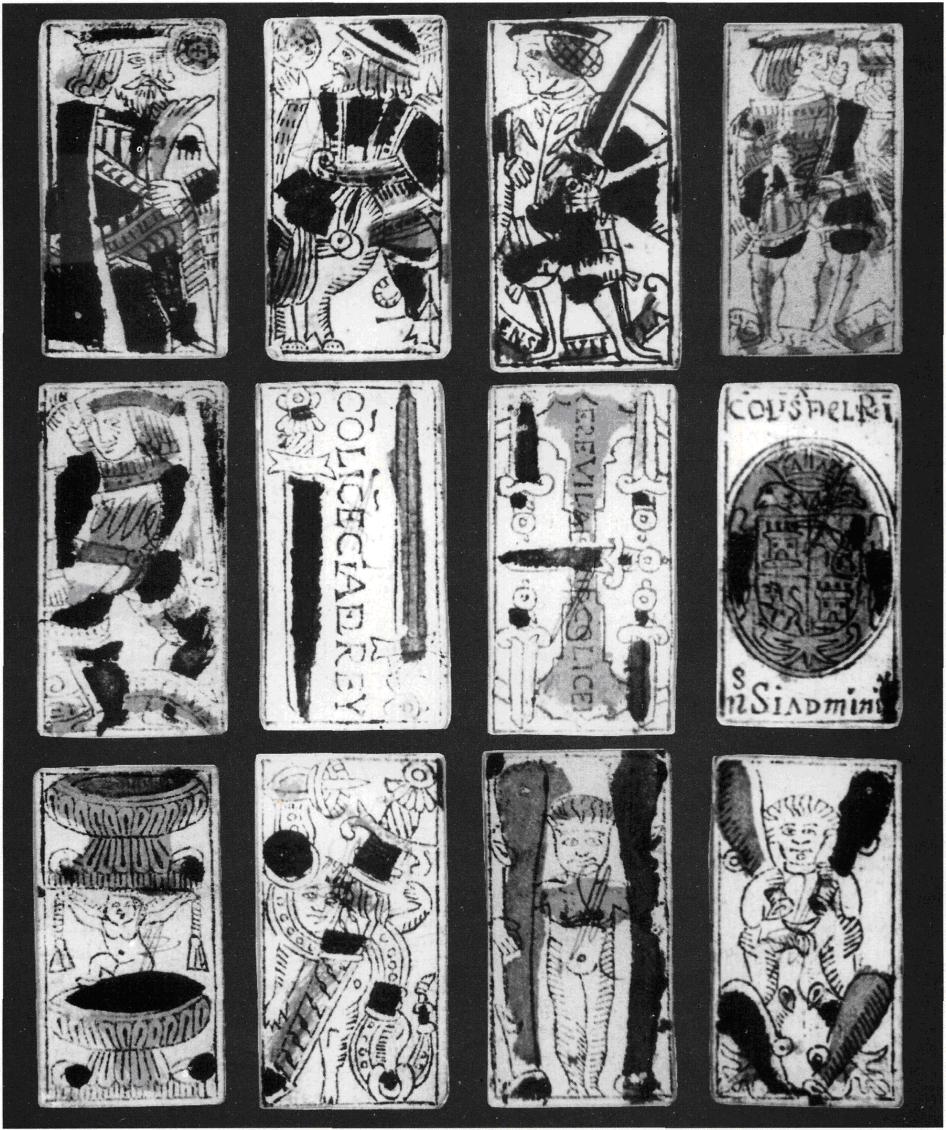

| Suit System: | S |
| Recommended Name: | the Seville pattern. |
The alternative name the Andalusian pattern has also been documented.
The following historical background is relevant to both the Seville and Madrid patterns and is therefore repeated in both pattern sheets.
The Kingdom of Spain was formed in 1496 only, when the King of Aragon (i.e. modern Aragon, Catalonia and Valencia) married the Queen of Castile (which comprised Andalusia as well as the Castiles). Subsequently, Charles V (I of Spain) and his successors reigned over a patchwork of entities where they were represented by viceroys. This was also true of Spanish overseas territories like Naples, Sicily and the Americas. In fact the King of Spain directly reigned only in Castile. This is why it was in this kingdom that playing-cards were taxed for the first time in European history: in 1543 Charles granted to a banker a monopoly (estanco) on the distribution of playing-cards, and later in the l6th Century the caption "con licencia del rey N[uestro] S[eñor]" (by permission of the King our Lord) was printed on some cards.
The image we have today of early Spanish playing-cards is very incomplete. However, a systematic examination of a large corpus of early Spanish cards housed in public and private collections shows at least two consistent patterns. This is confirmed by literary evidence, namely Francisco de Luque Fajardo: Fiel desengaño contra la ociosidad y los juegos (Madrid, 1603), who differentiated between "naipes de Castilla" and cards "en estampa de Andalucia".
The cards of Castile often bear the inscription "fechas en Madrid" (made in Madrid) whereas the cards from Andalusia generally bear "fechas en Sevilla". The latter are here called "Seville pattern".
The combination of features of the Seville pattern (some shared with other patterns) are: king of Coins wields an axe; cavalier of Coins is seen from three-quarter back; jack of Swords facing right carries a sword on his shoulder and has a banderole between his feet; jack of Cups and jack of Batons stand fullface; jack of Batons has one of his legs bent and a banderole between his feet; the motto "con licencia del rey N.S." appears on 2 and 5 of Swords; the ace of Coins shows the arms of Castile and Leon with the caption "en Sevilla" or "fechas en Sevilla" with a date. There are putti (muchachos) on 2 of Coins, ace of Swords, ace, 2 and 4 of Batons. The cards are usually rather small (about 40 x 80mm) and the figures may looked cramped. The Seville pattern bears some resemblance to the Franco-Spanish or Volay pattern [IPCS #38], which shows a muchacho on the ace of Swords too and has many courts in common.
Dated examples range between 1587 (British Museum) and 1708 (Bibliothèque National de France). The Seville pattern seems to have died sooner than the Madrid pattern [IPCS #51], but no date can be assigned with certainty.
The Seville Pattern was probably made in 40-and 48-card packs, with king, cavalier jack, plus ace to 9 or ace to 7.
Most of the cards or packs which have survived are anonymous. Although some of them were certainly made in Seville, others may have been made abroad, possibly in France.
ALFARO FOURNIER, Félix: Los Naipes (catalogue), Vitoria-Gasteiz, 1982.
BORVEAU, Alain: Anatomie d'un jeu de cartes: l'aluette ou le jeu de vache, Nantes, 1977.
COGORNO VENTURA, Gilda: Documentos naipes hallados en las excavaciones de la Huaca Tres Palos, Pando (Lima), (IN) Boletin del Seminario de Archeología, 5, 1970, pp. 1-39.
DENNING,Trevor: Spanish Playing-Cards, Birmingham, 1980.
DEPAULIS, Thierry: Portraits en Espagne avant 1800, (IN) The Playing-Card, XX/3, 1992, pp. 73-93.
DEPAULIS, Thierry: Portraits en Espagne (suite), (IN) The Playing-Card, XXI/4, 1993, pp. 116-125.
O'DONOGHUE, Freeman M.: Cataloque of the collection of playing cards bequeathed to the trustees of the British Museum by the late Lady Charlotte Schreiber, London, 1901.

| Cards by (?) S.A. and/or A.S., Seville, 1647 (Fournier 1982, Esp. 16). |
| The International Playing-Card Society | 7/1995 ThD |